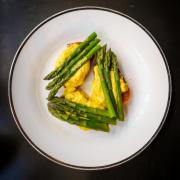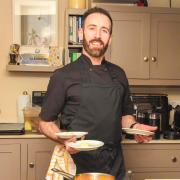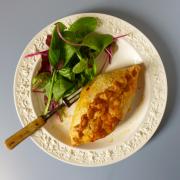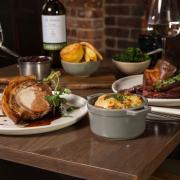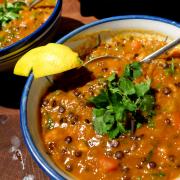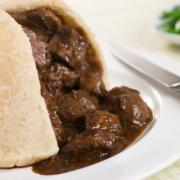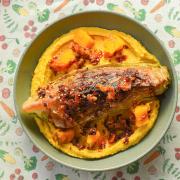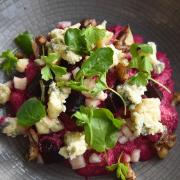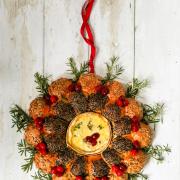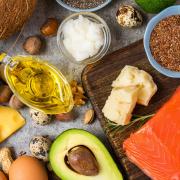Great Suffolk venison makes a delicious and healthy alternative supper for Stephen David, chef-director of Bespoke Events

Venison isn’t just super tasty, relatively cheap, very healthy plus a useful by-product in protecting crops and woods and improving road safety, it is now rightly and rapidly gaining in popularity in restaurants and when cooking at home.
Such a positive and beneficial good news story as a desirable ingredient, it is no surprise to hear that venison and game generally is the fastest-growing meat sector in retail sales year-on-year; even the better supermarkets are now stocking a wide range of different wild furred and feathered meats.
In these budget-conscious recessionary days, in comparison to other farmed meats, wild venison like all natural free-range game is surprisingly kind on the wallet, being much cheaper like-for-like to premium beef and lamb cuts.
Culinarily it is also distinctly a cook’s ideal companion – very flexible in recipes, versatile venison can readily and tastily replace red meat in virtually every recipe imaginable, so long as you give thought to its low fat content. A varied diet of herbs, grasses and tender farmers’ crops flavours it on the hoof and with its slow natural growth out roaming the countryside, well that all has to give tasty results on the plate. But you do need to keep it moist, so that means ‘the hare or the tortoise’ approach, choosing between swift cooking on the hob or long and slow in the oven; so for the former rustle up a juicy steak or marinaded stir-fry, or for the latter favour a rich casserole with dumplings or gentle braise in local beer or red wine.
The healthy cut
The health benefits of venison are hugely surprising, higher and lower in all the respective good and bad things, in these times of health-awareness, venison cannot be beaten when compared to traditional livestock; farmed meats, even skinless chicken breast, have more fat, and cholesterol-wise it is as low as you will find. Add in its very high iron content, increased vitamins and good levels of essential omega 3 fatty acids, and venison makes darn good tasty sense as a key part of your kitchen repertoire.
Buying local
There are essentially in East Anglia four main species of venison you are likely to find at the farmers’ market or on your local butcher’s counter.
If you like milder meats, and are perhaps not familiar with venison, look out for muntjac or roe deer types. This will be milder, sweeter and softer – very good for quick cooking in the frying pan or on the char-grill. Fallow and red deer are stronger and darker, with a rich texture and savoury flavour, better for slow gentle stewing.
One important plea is to know where you are buying your venison and where in turn your butcher or farm shop is sourcing it. Wild venison varies with species, and age also plays a key part. All game really does need to be on the younger side to get the tenderest results.
Whilst the larger red or fallow deer species are more robust, their less muscular cuts like loin or fillet will be milder in flavour and more tender, especially if from a young animal which has not been hung for many days. The older the beast the more hanging the carcass requires to tenderise the meat.
Venison from the smaller muntjac or roe species makes a good start for venison novices, as their meat really is similar to good beef or lamb in flavour and texture. So it is key to have a good independent trusted butcher who knows where his game is coming from and can advise you how flavoursome the particular type or cut will be and how to cook it. Our long-standing butcher friend is Jeremy Thickitt, who owns Clarke’s of Bramfield farm shop-butchery near Halesworth, and Emmerdale Farm Shop at Darsham, near Yoxford. He sources excellent venison, usually young fallow, which he properly hangs. Perfect . . .
A stalker’s dozen
As already explained, venison is almost the perfect universal replacement for red meats, so long as you obey the fast/hot and slow/cool principle for speed/temperature when cooking it.
Here are a stalker’s dozen (you always need one extra for luck):
Potted: slow cooked shoulder as a classic French rillettes, flaked when cool and packed into ramekins under a herbed garlic butter, is a treat with warm toast, port jelly, pickled walnuts and dressed watercress.
Burgers: swap the usual beef variety for some chargrilled venison patties, top with some crispy bacon and melted blue cheese in a good crusty granary roll for contrast
Roast Haunch (Leg): a dinner party classic, I would seek out a back leg of roe specifically for this, seal it on the hob with goose fat, season generously, start baking in a very hot oven and turn down until pink and juicy; perfect for Sunday lunch too.
Kebabs: venison really loves bold flavours, especially Middle Eastern spices; prepare a spiced herby coarse mince mix as you would for Turkish lamb kofte, griddle on soaked wooden skewers and eat in pitta with mint yoghurt, shredded red cabbage and pickled chillies
Toad in the Hole: a family weekday favourite, take lovely fat butchers venison sausages, wrap in fatty streaky bacon and pan fry with some forcemeat balls (packet stuffing is a fair speedy replacement); place in a very hot roasting tray strewn with slow-cooked red onions, add in your Yorkshire batter and cook to golden puffy perfection
Stew and Dumplings: a venison casserole is perhaps how we mostly find it on restaurant menus; slow-braised in wine or beer with root vegetables, herbs and condiments, it really does work well, melting in the mouth, richly savoury in flavour, a great way to introduce a novice to its tasty delights
Meatballs: a bowlfood staple on our menus, venison works well to replace our signature lamb meatballs spiked with red chilli, lemon, mint and Moroccan ras-el-hanout spices, served with a tomato, anchovies and cannellini beans in a rich ragù alongside simple buttered spaghetti and rocket leaves.
Wellington: for the ultimate celebration dish to spoil your loved ones, take venison loin or fillet browned all over, season with mustard, top with wild mushroom duxelles, wrap in thin smoky pancetta bacon, savoy cabbage leaves and savoury pancake, before a final overcoat of puff pastry and baking to pink perfection, heaven!
Stalker’s Pie: shepherd’s by any other name, substituting lamb for venison mince, being generous with the horseradish, Worcestershire sauce and redcurrant jelly as well as a good splash of port into your fried meat and stewed onions and carrots, finishing with root vegetable mash and strong cheddar for a great alternative lid.
Hotpot Cobbler: savoury mustard, parsley and cheese scone crust is a lovely difference to simple pastry or potato on top of a simple stew, cooked down for hours with some local stout
Mole/Chilli con carne: Mexican mole or the simpler chilli con carne is superb with venison instead of the more expected beef mince; I actually prefer it cooked in larger pieces, hand chop into thumbnail size nuggets. Mole’s secret ingredient is dark chocolate, which works so well with the smoky paste of dried chillies, warm spices and citrus, cooked down into a deep unctuous sauce.
Sauté: thin strips of marinaded venison steak simply sautéed and served on stir-fried cabbage, bacon and lentils with fresh thyme and garlic.
Bourguignon: the Burgundian classic, either floured and browned before gently braised withgood pinot noir wine, smoky bacon lardons, shallots and wild mushrooms or using these flavours and as a garnish and sauce for pan-fried steak or loin cuts (see recipe).
For more detailed recipes and further ideas, visit two excellent game cookery websites – www.gametoeat.co.uk and www.basc.org.uk/tasteofgame
Also seek out the excellent reference book Game: A Cookbook by Tom Norrington Davies and Trish Hilferty (ISBN 978-1906650100). w
Stephen David is chef-director of Suffolk-based Bespoke Events, providing restaurant quality cooking for wedding and party celebrations, with personal professional service, local Suffolk produce and fresh seasonal ingredients, award-winning chefs and attentive staff.
To find out more call Rebecca Mackenzie, event director 01986 802000 www.bespoke.events




